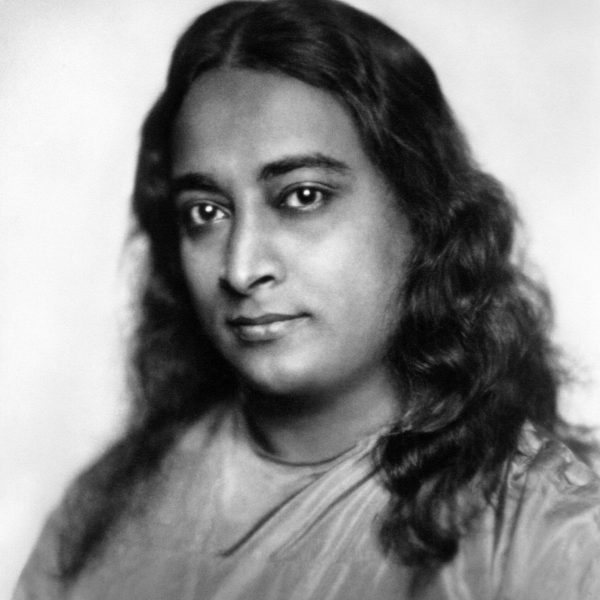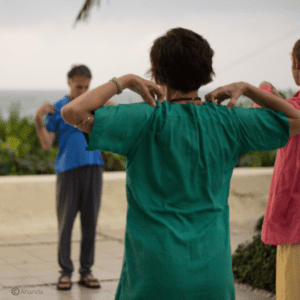Based on Yogic and Scientific Principles
This is a foundation level guide to learning Paramhansa Yogananda’s Energization Exercises.
Paramhansa Yogananda is considered as one of the most influential yogis of modern times. His exercises are based on the science of Yoga.
First, you’ll learn the basics to understand the impact of exercises on body, mind and energy.
If your day requires high energy tasks, you want to engage in some yogic techniques but you don’t find enough time, you’ll find this guide helpful.
Let’s begin!
Table of Contents

Paramhansa Yogananda (1893 - 1952)
Paramhansa Yogananda born as Mukunda Lal Ghosh in Gorakhpur, India. He was a self-realized yogi.
Yogananda introduced Meditation and Kriya Yoga to millions of people across India and America.
His Guru Swami Sri Yukteswar sent him to the West in 1920s on a special mission.
His mission was to show unity between Eastern and Western religions. The balance between Western materialism and Eastern Spiritualism. He was concerned for the upliftment of all mankind.
In the mid-1940s he published his book Autobiography of a Yogi, which has introduced millions to the wonders of yoga.
Harper SanFrancisco listed it as one of the “100 best spiritual books of the 20th Century.”
Yogananda’s Contribution To The Science Of Yoga
Yogananda discovered that, through will power, we can send energy to the various parts of the body. He then made this discovery practical by devising a system of body-cell recharging called the Energization Exercises.
These exercises are Paramhansa Yogananda’s unique contribution to the science of yoga. They use a combination of concentration, will, and breath to direct the flow of energy to various body parts. This flow is sent and withdrawn by tensing and then relaxing the muscles in the area we want to recharge.
Energy control is a fundamental part of the science of yoga. We are beings of energy.
Yogic Principles
Paramhansa Yogananda explained that we draw prana indirectly through the food we eat, as well as through oxygen and sunlight. These indirect sources of energy, however, are like the water you put into the battery of your car. When the battery runs down, no amount of water will make it work again. You have to recharge the battery from another source.
Similarly, Yogananda explained, our bodies live only indirectly from food, but we live directly from the cosmic energy that flows into our bodies through the medulla oblongata at the base of the brain.
It would be hard to overstate the value of these exercises, which were developed by Yogananda specifically to teach us how to gain control over subtle energy (prana).
Yogananda said that if we were stranded on a desert island and could have only one yogic technique, we should choose the Energization Exercises because through them we would eventually discover the entire science of yoga.
Our bodies, our health, our happiness, our very thoughts are determined by the level and direction of our energy.
In order to change something, it is much more effective to learn to control energy.
If we can learn to control our prana and change the underlying patterns sufficiently, we can work miracles for ourselves and others.
Scientific Principles
“Yogoda [Energization]” teaches how to surround each body cell with a right of super-charged electrical vital energy and thus keep free from decay of bacterial invasion.
Wisdom Window: The word Yogoda is derived from “Yoga,” meaning harmony or equilibrium, and “da,” that which imparts. Hence “Yogoda” means that system which imparts harmony and equilibrium to all the forces and faculties working for the perfection of body, mind, and soul.
It keeps not only the muscles, but all the tissues of the body, bones, marrow, brain, and cells in perfect health.”
“Yogoda brings about the growth of all the cells and tissues. It teaches how to recharge the body battery with fresh life current by increasing the will power.
It gives specific methods to strengthen and recharge the muscles, not only collectively, but individually, with vital force.
It establishes harmony between the working of the voluntary muscles and the involuntary processes. And this harmony gives wonderful health and strength.”
“Yogoda causes the resurrection of dying tissue cells and worn out facilities and the formation of billions of new cells and fresh facilities all through the right exercise of will. Through it all the various tissues—bony, muscular, connective, nerve, etc.—are proportionately formed and the mind is strengthened.
The circulation, respiration, digestion, and all other involuntary processes of the body are harmonized and invigorated, the mind is clarified.”
“Yogoda teaches the art of consciously sending the curative life energy to any diseased body part. By its aid the general vitality of the body is markedly raised, resulting in a wonderful development of tissue, strength, and unexpected nerve vigor, thereby insuring greater longevity.
Memory and brain power are also increased through greater blood supply.”
[copyright]
Benefits to the Body, Mind and Soul

Here is just a partial idea of the benefits of being able to control and harmonize the flow of prana.
In the Body
- We can have boundless energy for work, relationships, and fun.
- When we become tired, we can recharge the body and mind instantaneously. We can have vibrant good health since the cells in our body would always be highly energized.
- If we are injured, we can heal the injuries. Does this sound impossible? It wasn’t for Jesus or Yogananda or other advanced yogis. Does it mean we will never get ill? Not necessarily, but if we do get ill we can consciously direct sufficient healing energy to allow us to quickly regain our health.
In the Mind
- We can easily focus the mind on the task at hand, whether work or meditation.
- Success is guaranteed because we are able to apply the energy needed to overcome any obstacles in our path.
- We would have negative moods only rarely, and if they came, we would have a way of dealing with them, since our moods and thoughts are dependent upon our level of energy.
- We can find it much easier to overcome unwanted attitudes and habits.
In the Soul
We can find it easy to go into deep meditation and quickly attain stillness of mind and openness of heart.
Introduction To Energization Exercises Technique
Yogananda began to teach the Yogoda Exercises in 1918 at his boys’ school in Ranchi, India. In his lessons in the 1920s he shared the exercises given below.
It all starts by learning to feel and direct the flow of prana (life-force)
Paramhansa Yogananda gave us the axiom “The greater the will, the greater the flow of energy.”
Will power should be applied with intensity, but not grimly or with tension. It might help you to think in terms of willingness, enthusiasm, and joy.
These Energization Exercises are a means of using will, with awareness of energy, to consciously draw cosmic energy into the body.
As you do the movements of the exercises, try to feel the flow of energy and be conscious of that flow. Then, by use of your will power, you can direct the flow of energy to specific parts of the body.
The more you become aware of using your will power to direct that energy, the more you will be able to increase the flow.
Exercise Demonstration
Close your eyes and gaze, as in meditation, toward the spiritual eye – a point between the eyebrows.
Concentrate your attention in the area of the medulla.

Now tense your right hand and forearm, feeling that you are sending energy from the medulla to hand and forearm. Continue tensing harder and harder until your hand is vibrating with the effort.
Now relax the muscles and feel the energy in the area you have just tensed.
At first what you’ll feel is just the tension inside of the muscles. Then you’ll experience the flow of energy which creates the tension in those muscles.
Finally, you will become aware of how you can direct that flow. It may help to visualize a flow of light.
It is important, however, to try to feel the flow of energy. It is essential to concentrate as deeply as possible.
Now repeat the same thing on the other side, tensing, and then relaxing, the left hand and forearm.
Begin with this Prayer
“O Infinite Spirit,
Recharge my body with Thy cosmic energy,
My mind with Thy concentration,
My soul with Thy ever-new joy.
O eternal youth of body and mind,
Abide in me forever and forever.”
Video: 39 Energization Exercises in 15 Minutes
Learn Energization Exercises
Important Guidelines In Paramhansa Yogananda’s Words

- Ten minutes’ daily practice will give results unequalled by those of most other forms of exercise. It avoids the bad effects of some other systems, such as exhaustion of the heart and other organs, and failure to give all-round development.
- It helps one detach the scattered attention from the senses and restless habits, and concentrate on one thing at a time.
- Never say, “I am tired.” Work willingly. As you work, feel the eternal energy flowing in you ceaselessly. Each person wishes to be great in his own field, but often he cannot realize his wish. Why? Because people have no control over their bodies.
- The exercises are to be done slowly at first, gently and rhythmically, never jerkily. Every movement must be harmonious. If any part of the body is especially weak, send the energy very slowly and gently, using only low tension. That body part will gradually be strengthened.
- Exercise very slowly, willingly, and pleasantly, with eyes closed. By keeping the eyes closed concentration is keener, and energy currents are prevented from escaping through the eyes.
- Practice regularly upon arising and whenever tired.
- When performing the exercises, keep your mind on the medulla and imagine the energy flowing into your body through the medulla and from there to every part of the body. Always hold the thought, “I am calmly active; I am actively calm.”
Practical Exercise - Do this from today [Routine]
- Practice the exercises every day at least once, and preferably twice a day. Each exercise should be done from three to five times.
- Once you have learned all the exercises it should take 10-15 minutes to do them.
- Energization can be practiced before meditation to release tensions and allow you to go deeper and sit more still in meditation, or at any time.
- It is best to practice the exercises outdoors. If you are unable to do this make sure you do them in front of an open window or door where fresh air can enter.
- Modify if necessary. If you have back, neck or any special physical problems or if a body part is ill or injured, modify the exercises for these body parts or practice the exercises for these areas mentally or with low tension only. It may be helpful to visualize a current of light flowing to the affected part.
- Isolate the body part being tensed. If you cannot isolate a specific muscle or body part, put your mind there and the energy will automatically flow to that part. Later you may be able to actively locate and tense the muscles there individually.
- Try to do all the exercises. While you are learning them, you can begin by learning and practicing a few of the exercises at a time until you’ve worked up to doing them all each day. You might try practicing the first five or so exercises for a week, then adding more the next week, and so on.
- Relax the mind, setting aside all thoughts of past and future.
- Do the exercises with joy and willingness. Feel that you are giving your body a “breakfast of energy”.
Source – Compiled excerpts from the book “Lessons in Meditation” by Jyotish Novak



